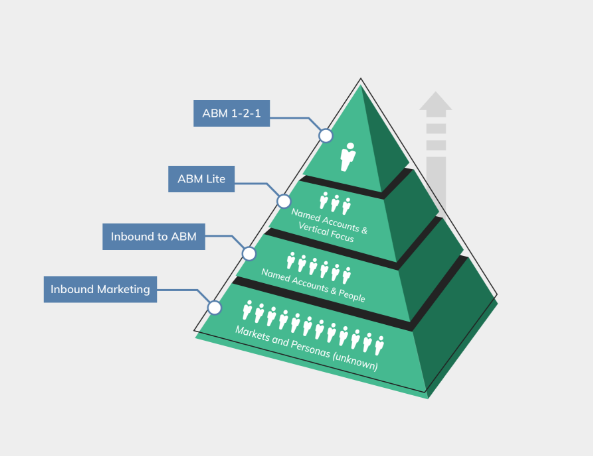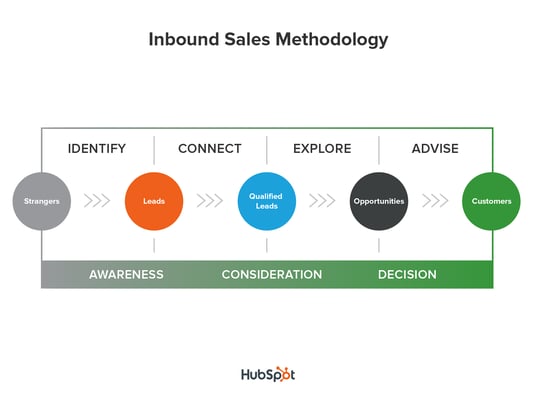What is Account-Based Marketing (ABM) and how does it align with inbound marketing? We explore different ABM maturity levels and starting points to see how it can fit in tangent with inbound.

What Is ABM?
Also known as key-account targeting, Account Based Marketing (ABM) is a strategic marketing approach that treats a best-fit account (this may be a specific individual, a company, a vertical, or even a cluster - such as a group of job titles) as a market of one.
An Account-Based Marketing strategy is designed to appeal to high yield prospects at a very detailed level. ABM works to target specific company accounts and build relationships with ideal prospects within them.
As a highly personalised strategy, ABM offers precise, focussed lead generation, and long-term customer relationships as a result of relevancy. You may have heard ABM described as a strategy that 'flips the funnel' to treat customers as a market of one, rather than targeting a wider persona demographic as inbound and other, traditional lead gen strategies do.
However, that doesn't mean that inbound and ABM are incompatible.
In fact, when aligned with an Inbound marketing and sales strategy, ABM activities give organisations the best chance to secure the very best fit opportunities for solid growth and revenue, and retain good-fit clients long-term.
ABM isn’t just about knowing which companies to target, but about which decision makers at those accounts to engage, and how to engage them. - Scott Vaughan, CMO, Integrate
Benefits Of Account-Based Marketing
84% of B2B marketers believe ABM provides significant benefits for retaining and expanding current relationships. - Sirius Decisions
Working to target high-value, high propensity accounts and build relationships with your ideal prospects, ABM offers multiple benefits. Companies using ABM to support their marketing approach can:
- Develop trust and buy-in with large, complex organisations and key stakeholders within them
- Better prove the value of complex service offerings
- Align marketing and sales as holistic business partners
- Minimise both sales and marketing time/resource wastage
- Reduce sales cycle length
- Create more effective, personalised marketing strategies that achieve clear ROI
- Develop stronger relationships with more valuable clients, and so reduce churn
Understanding Different Levels of ABM: How Does ABM fit with Inbound?
Like Inbound, ABM is all about generating quality opportunities rather than quantity. It’s a tactic that employs help-driven, relevant relationship building and value-focussed communication.
Essentially ABM takes the buyer persona focus of Inbound to the next level. Instead of using a more generic (but data-backed) persona as the foundation of all campaign activity, the founding focus of the marketing strategy is a specific key account, company or set of identified individuals. As a result, ABM is a great supporting activity to consider when running Inbound activities.
Of course different marketers will start with ABM at different points, depending their maturity level.

At Strategic, we have four defined tiers of ABM, which address a range of starting points or ABM maturity levels. At the base of the triangle we have an inbound level (for those who lack in depth account insight), and each tier moves up a notch on an 'inbound to ABM' journey, up to the ABM 1-2-1 level (for those with clear insight on the exact high-value, high-propensity accounts and stakeholders that their campaign will target). Essentially your starting point with ABM will depend on the insight you have; driving your ability to focus your campaign and content at a cluster, company or individual stakeholder level.
Who Should Consider ABM?
Just like Inbound, B2B organisations with lengthy sales cycles tend to be those who reap greatest benefits from ABM, reducing churn and time-to-sale. Due to the ‘opportunity vs. resource’ investment required, ABM is typically suited to larger enterprise organisations with longer sales cycles, sizeable customers, and complex solution propositions (such as IT and software companies).
80% of marketers measuring ROI say that ABM outperforms other marketing investments - ITSMA
What Is Account-Based Sales?
Companies are 67% better at closing deals when sales and marketing teams are in sync - Marketo
In modern B2B marketing, and in an Inbound marketing process, alignment between marketing and sales teams is crucial. Both sides need to work together to ensure that not only are leads generated, but that they are quality leads and a good-fit for the business.
Notably, for an ABM campaign to be successful, marketing and sales must also be aligned, using their combined business intelligence to form account-driven, relevant campaigns. Think of ABM as the ultimate alignment between marketing and sales.
In an Inbound sales process, the sales methodology can be considered in the following way:
- Identify - Listen for active, persona-relevant buyers and prioritise active buyers over passive buyers.
- Connect - Earn the trust and attention of today’s empowered buyers by leveraging context to begin personalised, valuable conversations that address pain at the appropriate buyer’s journey stage.
- Explore - Focus on good-fit leads, explore their interest and leverage it to develop further trust and uncover deeper goals.
- Advise - Continue to nurture and advise buyers, leveraging the information learned in the explore phase.

In an Account-Based Sales structure, sales actions are similar, but with a starting point focussed around creating a single view of each target account, rather than a broader persona focus:
- Create a single view of each target account. i.e. focus on specific organisations (accounts) who are a best fit for your business, rather than in wider ‘lead generation’ terms.
- Identify target prospects within each account who make up the Decision Making Unit (DMU). Identify the best contacts within each account who make up the DMU to connect with. These may be key decision makers, those with purchase authority or they may be a group of multiple target individuals within your target account.
- Develop relevant content. Successful marketing is fueled by relevant content, and ABM is no different. However, unlike regular persona-targeted content, ABM content is hyper-personalised to send a specific message to a specific account. You may have whole pieces of content, landing pages etc. dedicated to solving that account’s unique issues.
- Follow appropriate sales outreach. This is where the basics of the Inbound sales methodology comes in. For best results, connect appropriately (such as via social selling) and build relevant relationships with your target account prospects - on their terms and timescale. You can then work to better identify the challenges your key accounts have, and continue to refine your content and messaging to progress them exclusively through the funnel.
Understanding how to plan and implement effective ABM campaigns can be complex. But for targeted, long-term customer relationships, ABM can offer some of the best results.




